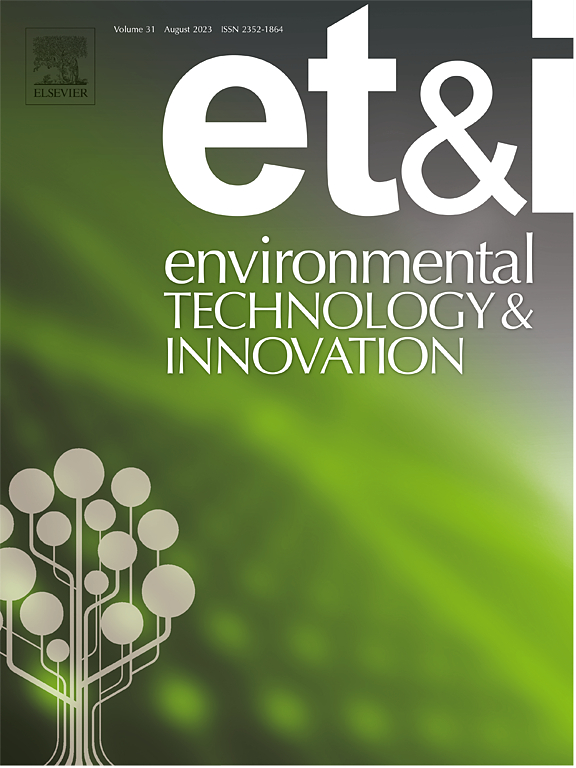温度、pH和反应时间对聚3-羟基丁酸盐碱热预处理的影响:促进增溶和厌氧甲烷生成
IF 6.7
2区 环境科学与生态学
Q1 BIOTECHNOLOGY & APPLIED MICROBIOLOGY
引用次数: 0
摘要
采用32×4全因子设计,考察了操作参数(温度37 ~ 91℃,pH 7 ~ 13,预处理时间24 ~ 120 hr)下碱热预处理对聚3-羟基丁酸酯(P3HB)的增溶和连续厌氧消化的影响。通过碱热预处理,P3HB几乎完全溶解(99.6 %)。P3HB的碱热预处理显著提高了CH4的产量,使CH4的产量提高了23倍(73 mL CH4/g VSS/d),完成厌氧消化的批次时间减少了88 %,CH4的产量为380 mL CH4/g COD。预处理因子,尤其是pH对预处理效果有显著影响,且与温度有协同效应。本研究综合了析因设计、响应面建模和微生物分析,以全面了解预处理条件如何影响P3HB厌氧消化的性能和微生物动力学。部分立方模型的响应面分析成功地量化了这些关系,并观察到增溶与CH4产率之间存在很强的正相关关系。不同的细菌和古菌群落增殖在厌氧消化预处理与未预处理的P3HB。Spirochaetaceae、Syntrophomonas、Mesotoga、Christensenellaceae R-7 group和Sedimentibacter以及Methanosaeta和candidatus Methanofastidiosum等产甲烷菌被确定为P3HB厌氧消化的关键因素。这些发现支持优化的碱热预处理显著增强P3HB的厌氧消化,强调了P3HB废物作为厌氧消化过程的潜在原料的潜力。本文章由计算机程序翻译,如有差异,请以英文原文为准。
Effect of temperature, pH and reaction time on alkali-thermal pretreatment of poly(3-hydroxybutyrate): Enhancing solubilization and anaerobic CH4 production
The effects of alkali-thermal pretreatment with operational parameters (temperature: 37–91 °C, pH: 7–13, pretreatment time: 24–120 hr) on the solubilization and the consecutive anaerobic digestion of poly(3-hydroxybutyrate), P3HB, was investigated using the tests with 32×4 full factorial design. Near-complete solubilization of P3HB (99.6 %) was attained through the alkali-thermal pretreatment. Alkali-thermal pretreatment of P3HB significantly improved CH4 production, resulting in 23-fold enhancement in the CH4 production rate (73 mL CH4/g VSS/d) and an 88 % reduction in elapsed batch time for complete anaerobic digestion, with a CH4 yield of 380 mL CH4/g COD. Pretreatment factors, particularly pH, exerted significant effects and showed synergistic effects with temperature. This study integrated factorial design, response surface modeling, and microbial analysis to offer a comprehensive understanding of how pretreatment conditions affected both performance and microbial dynamics in P3HB anaerobic digestion. Response surface analysis with partial cubic models successfully quantified these relationships, and strong positive correlations between solubilization and CH4 yield were observed. Distinct bacteria and archaea communities proliferated during the anaerobic digestion of pretreated versus unpretreated P3HB. Spirochaetaceae, Syntrophomonas, Mesotoga, Christensenellaceae R-7 group, and Sedimentibacter, along with methanogens such as Methanosaeta and candidatus Methanofastidiosum, were identified as key contributors to the anaerobic digestion of P3HB. These findings support that optimized alkali-thermal pretreatment significantly enhances the anaerobic digestion of P3HB, underscoring the potential of P3HB wastes as prospective feedstocks for anaerobic digestion process.
求助全文
通过发布文献求助,成功后即可免费获取论文全文。
去求助
来源期刊

Environmental Technology & Innovation
Environmental Science-General Environmental Science
CiteScore
14.00
自引率
4.20%
发文量
435
审稿时长
74 days
期刊介绍:
Environmental Technology & Innovation adopts a challenge-oriented approach to solutions by integrating natural sciences to promote a sustainable future. The journal aims to foster the creation and development of innovative products, technologies, and ideas that enhance the environment, with impacts across soil, air, water, and food in rural and urban areas.
As a platform for disseminating scientific evidence for environmental protection and sustainable development, the journal emphasizes fundamental science, methodologies, tools, techniques, and policy considerations. It emphasizes the importance of science and technology in environmental benefits, including smarter, cleaner technologies for environmental protection, more efficient resource processing methods, and the evidence supporting their effectiveness.
 求助内容:
求助内容: 应助结果提醒方式:
应助结果提醒方式:


